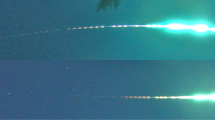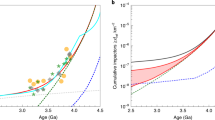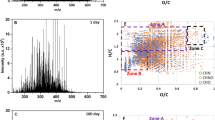Abstract
SATURN'S planet-sized moon Titan has a nitrogen-rich atmosphere with a surface pressure of 1.6 bar (ref. 1). Methane, ethylene and other hydrocarbons are also present, allowing photochemical synthesis of complex organic molecules and aerosols2–6. The ablation of meteoroids in Titan's upper atmosphere could contribute to the atmospheric chemistry in two important respects. First, refractory elements such as sodium, iron and magnesium could recondense into small (10–100 Å) particles which could act as aerosol nucleation centres, as in the Earth's atmosphere7,8. Second, meteoroids from stray bodies with perihelia of ⩾3 AU could be rich in volatile ices (H2O, CO2, CO), and might constitute an important source of oxygen-bearing material in Titan's atmosphere. Here I use a simple model of meteoroid ablation to calculate the altitude profiles of material introduced in this way from both icy and rocky meteoroids. The source region of oxygen-bearing molecules is found to lie between 600 and 800 km altitude ; on Earth, by comparison, most of the meteoritic material evaporates between 80 and 100 km (refs 9,10).
This is a preview of subscription content, access via your institution
Access options
Subscribe to this journal
Receive 51 print issues and online access
$199.00 per year
only $3.90 per issue
Buy this article
- Purchase on Springer Link
- Instant access to full article PDF
Prices may be subject to local taxes which are calculated during checkout
Similar content being viewed by others
References
Hunten, D. M. et al. in Saturn (eds Gehrels, T. & Matthews, M. S.) 671–759 (Univ Arizona Press 1984).
Strobel, D. F. Icarus 21, 466–470 (1974).
Strobel, D. F. Planet. Space Sci. 30, 839–848 (1982).
Yung, Y. L., Allen, M. & Pinto, J. P. Astrophys. J., Suppl. 55, 465–506 (1984).
Podolak, M., Noy, N. & Bar-Nun, A. Icarus 40, 193–198 (1979).
Podolak, M. & Podolak, E. Icarus 43, 73–84 (1980).
Rosinski, J. & Snow, R. H. J. Meteor. 18, 736–745 (1961).
Hunten, D. M., Turco, R. P. & Toon, O. B. J. atmos. Sci. 37, 1342–1357 (1980).
Gadsen, M. J. atmos. terr. Phys. 30, 151–161 (1968).
Hughes, D. W. in Cosmic Dust (ed McDonnell, J. A. M.) 123–180 (Wiley, New York, 1978).
Lutz, B. L., de Bergh, C. & Owen, T. Science 220, 1374–1375 (1983).
Muhleman, D. O., Berge, G. L. & Clancy, R. T. Science 220, 1374–1375 (1984).
Marten, A. et al. Icarus 76, 558–562 (1988).
Bronshten, V. A. Physics of Meteoric Phenomena (Reidel, Dordrecht, 1983).
Podolak, M., Pollack, J. B. & Reynolds, R. T. Icarus 73, 163–179 (1988).
Ip, W-H. & Fernandez, J. A. Icarus 74, 47–61 (1988).
Fechtig, H., Leinert, C. & Grün, E. in Landolt-Börnstein Numerical Data and Functional Relationships in Science and Technology New Series, Vol. 2, 228 (Springer, Heidelberg, 1981).
Ip, W-H. Astrophys. J. (in the press).
Author information
Authors and Affiliations
Rights and permissions
About this article
Cite this article
Ip, WH. Meteoroid ablation processes in Titan's atmosphere. Nature 345, 511–512 (1990). https://doi.org/10.1038/345511a0
Received:
Accepted:
Issue Date:
DOI: https://doi.org/10.1038/345511a0
This article is cited by
-
Lower and Upper Ionosphere of Mars
Space Science Reviews (2014)
-
Meteoric Layers in Planetary Atmospheres
Space Science Reviews (2008)
-
Optical Observations of Meteors
Earth, Moon, and Planets (2004)
Comments
By submitting a comment you agree to abide by our Terms and Community Guidelines. If you find something abusive or that does not comply with our terms or guidelines please flag it as inappropriate.



